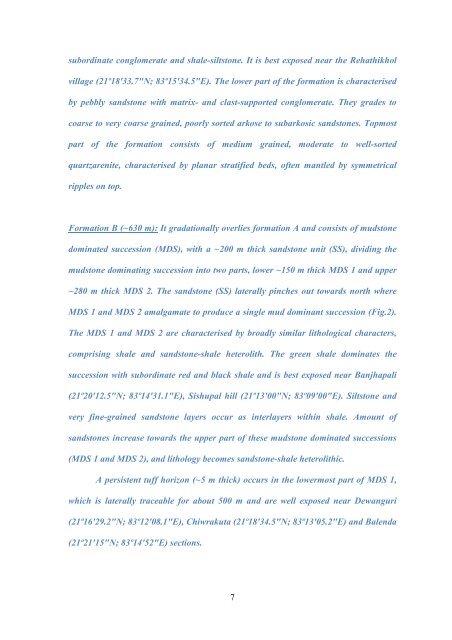of the Singhora-Saraipali area, south-eastern Chattisgarh Basin - fieldi
of the Singhora-Saraipali area, south-eastern Chattisgarh Basin - fieldi
of the Singhora-Saraipali area, south-eastern Chattisgarh Basin - fieldi
Create successful ePaper yourself
Turn your PDF publications into a flip-book with our unique Google optimized e-Paper software.
subordinate conglomerate and shale-siltstone. It is best exposed near <strong>the</strong> Rehathikhol<br />
village (21º18'33.7"N; 83º15'34.5"E). The lower part <strong>of</strong> <strong>the</strong> formation is characterised<br />
by pebbly sandstone with matrix- and clast-supported conglomerate. They grades to<br />
coarse to very coarse grained, poorly sorted arkose to subarkosic sandstones. Topmost<br />
part <strong>of</strong> <strong>the</strong> formation consists <strong>of</strong> medium grained, moderate to well-sorted<br />
quartzarenite, characterised by planar stratified beds, <strong>of</strong>ten mantled by symmetrical<br />
ripples on top.<br />
Formation B (~630 m): It gradationally overlies formation A and consists <strong>of</strong> mudstone<br />
dominated succession (MDS), with a ~200 m thick sandstone unit (SS), dividing <strong>the</strong><br />
mudstone dominating succession into two parts, lower ~150 m thick MDS 1 and upper<br />
~280 m thick MDS 2. The sandstone (SS) laterally pinches out towards north where<br />
MDS 1 and MDS 2 amalgamate to produce a single mud dominant succession (Fig.2).<br />
The MDS 1 and MDS 2 are characterised by broadly similar lithological characters,<br />
comprising shale and sandstone-shale heterolith. The green shale dominates <strong>the</strong><br />
succession with subordinate red and black shale and is best exposed near Banjhapali<br />
(21º20'12.5"N; 83º14'31.1"E), Sishupal hill (21º13'00"N; 83º09'00"E). Siltstone and<br />
very fine-grained sandstone layers occur as interlayers within shale. Amount <strong>of</strong><br />
sandstones increase towards <strong>the</strong> upper part <strong>of</strong> <strong>the</strong>se mudstone dominated successions<br />
(MDS 1 and MDS 2), and lithology becomes sandstone-shale heterolithic.<br />
A persistent tuff horizon (~5 m thick) occurs in <strong>the</strong> lowermost part <strong>of</strong> MDS 1,<br />
which is laterally traceable for about 500 m and are well exposed near Dewanguri<br />
(21º16'29.2"N; 83º12'08.1"E), Chiwrakuta (21º18'34.5"N; 83º13'05.2"E) and Balenda<br />
(21º21'15"N; 83º14'52"E) sections.<br />
7









